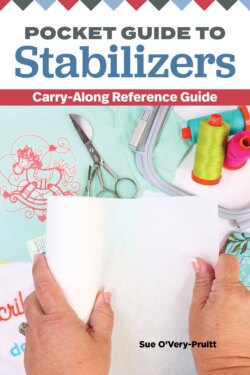Читать книгу Pocket Guide to Stabilizers - Sue O'Very-Pruitt - Страница 7
На сайте Литреса книга снята с продажи.
ОглавлениеBefore You Begin
When you are first learning machine embroidery, the variety of stabilizers may seem overwhelming. You might be wondering, Why are there so many stabilizers, and how do I choose?
There are so many types of stabilizers because there are so many types of materials and embroidery designs, as well as various ways to “hoop” materials. Some areas of fabric, such as napkin corners and shirt collars, cannot be hooped.
It is a good idea to have a stash of test materials to try out before stitching on your real project. The next time you are at the discount store, grab some napkins, towels, and T-shirts to use for test stitching. Most importantly, enjoy trying new materials, embrace the mistakes, and have fun!
BACKINGS VERSUS TOPPINGS
Before we discuss the various types of stabilizers, it is important to understand where they are applied. There are two options: either on the back of the material (backings) or on top of the material (toppings). Backings are more common, as nearly every embroidery project requires some sort of stabilization. Toppings are usually used in conjunction with backings. Most every type of stabilizer can be used as a backing, while only a few are appropriate as toppings.
This pocket guide discusses backings and toppings when referring to different types of stabilizers and their application. For example, when embroidering a terrycloth towel, the backing is a tear-away and the topping is a wash-away.
Stabilizer is most commonly used on the back of materials, but some projects call for toppings as well.
